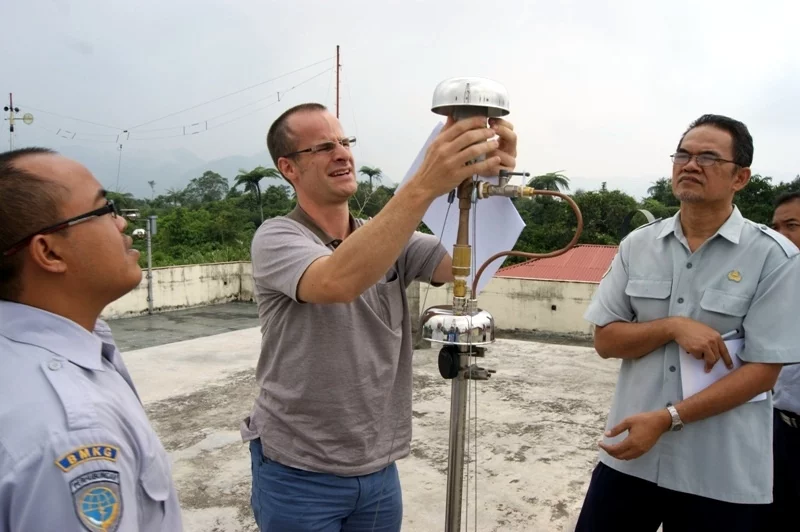Aerosols are small particles in the atmosphere. They can influence the global climate by way of direct absorption or scattering of solar radiation, or by acting as nuclei for cloud formation. Efforts by scientists to exactly quantify these effects and then improve climate models are impeded by the lack of a global network of aerosol measurement stations. To remedy this situation, researchers at the Paul Scherrer Institute (PSI) are working on the project CATCOS (Capacity Building and Twinning for Climate Observing Systems) , which is coordinated by the Federal Office of Meteorology and Climatology MeteoSwiss and funded by the Swiss Agency for Development and Cooperation (SDC). The objective is to facilitate continuous aerosol measurements at sites where the paucity of data is the greatest: in developing countries and countries in transition, particularly south of the equator.
The most recent report of the Intergovernmental Panel on Climate Change (IPCC) once again clearly highlighted the uncertainty surrounding the atmospheric aerosol loading. Although climate scientists are almost sure that aerosols contribute overall to a cooling rather than a warming of our planet, it is still unclear how substantial this cooling is.
Direct and indirect influences
Aerosols have a direct and an indirect impact on climate. Direct because they themselves absorb or scatter solar radiation, preventing it from warming the Earth’s surface. Indirect because they can act as nuclei on which cloud droplets can grow. These droplets then prevent some of the solar energy from reaching the lower layers of the atmosphere. Since the formation of clouds and their interaction with solar radiation are very complex processes, there is still considerable uncertainty surrounding the indirect climate impact of aerosols. The direct impact has to be elucidated more clearly, too. The uncertainty stems to a considerable extent from the shortage of aerosol measurement stations in regions with a high aerosol load like Africa or south-east Asia. Generally speaking, there is a great need to increase the density of the measurement network south of the equator. PSI researchers in the CATCOS project have set themselves the task of remedying this shortcoming. CATCOS monitors not only aerosols but also the concentration of greenhouse gases (by Empa – the Swiss Federal Laboratories for Materials Science and Technology) and the development of glaciers (by the Universities of Zurich and Fribourg). The project is co-ordinated by MeteoSwiss.
Scarcely investigated hotspots
Setting up and running aerosol measurement stations is an ambitious and resource intensive endeavour. However, aerosol measurements in less developed countries are the key to understanding climate dynamics on a global and regional scale. That’s why SDC is supporting these countries within the framework of CATCOS. The PSI Laboratory of Atmospheric Chemistry inputs its expertise in aerosol measurements. So far, thanks to CATCOS, measurement stations are now up and running in Indonesia and Chile. In 2014 two further stations are scheduled for completion, one in Kenya and the other in Vietnam. These locations are aerosol loading hotspots that have scarcely been investigated at all up to now. In Africa, for instance, the burning of wood for cooking leads to the release of a considerable amount of aerosols into the atmosphere. As measurement data are almost non-existent, the uncertainty in estimating the actual aerosol concentration is greatest here and in eastern Asia. Substantial aerosol emissions are also generated in countries like Indonesia, where it is common practice in agriculture to burn down forests to free up land for crop growing.
Identifying aerosol types
The measurement stations run by the PSI researchers measure the local aerosol load at one-minute intervals. In particular, the direct interaction between aerosols and sunlight is characterised, i.e. their light absorption and scattering. Absorption is measured using an aethalometer. This instrument contains a filter onto which the aerosols in an air sample are deposited. The change in light intensity passing through the filter is measured and from this, the light absorbed by the aerosols can be determined. Aerosol light scattering is measured using a separate instrument; a nephelometer. In this instrument, detectors surround an air sample, and the amount of light scattered by the aerosols in each direction is measured . The measurements are done using light of different wavelengths in order to determine not only the total aerosol volume but also the aerosol types present. For example, aerosols from wood incineration absorb more UV light. A decrease in UV intensity, therefore, permits conclusions about the presence of aerosols of this kind. By contrast, soot particles are characterised by a drop in the amount of infrared radiation measured.
Robustness and sustainability
The instruments used are all commercially available. However, the PSI researchers have adapted the instruments to ensure a minimum number of breakdowns. “These devices are highly complex and therefore liable to break down. But we want to ensure low maintenance operation in the near term.”, says PSI researcher Nicolas Bukowiecki. He is responsible for the technical and scientific co-ordination of the project. To ensure the sustainable use of the measurement stations, the CATCOS team has introduced a few changes compared to earlier projects. One new feature is, for instance, that the measurement stations are not handed over to the countries in which they are located as soon as they are up and running. In the past this practice led to stations not being operated for long periods, either due to high running costs or for technical reasons. In the CATCOS project the goal is, therefore, to accompany the transition to independent operation over a longer period. During this transitional period local technicians, data experts and scientists are to receive the relevant training.
Text: Leonid Leiva
Additional information
CATCOS' WebsiteLaboratory of Atmspheric Chemistry
Contact
Dr. Nicolas Bukowiecki, Laboratory of Atmspheric Chemistry, Paul Scherrer Institute,Telephone: +41 56 310 24 65 , E-Mail: nicolas.bukowiecki@psi.ch

